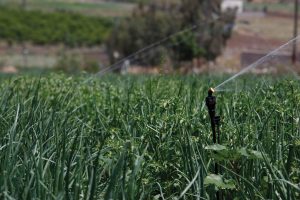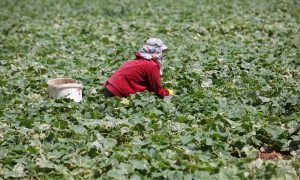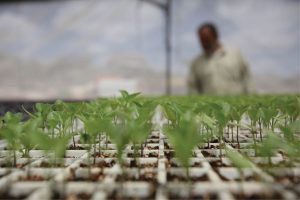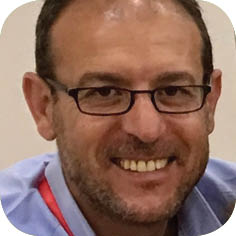The Global Environment Facility’s Small Grants Programme (GEF/SGP) is a global program that engages civil-society organizations and supports local leadership to achieve global environmental sustainability and improve local livelihoods. The program supports initiatives in climate-change mitigation and adaptation, biodiversity conservation, protection of international waters, reduction of the impact of persistent organic pollutants, and prevention of land degradation whilst generating sustainable livelihoods.
Partnering with GEF/SGP since 1996, the United Nations Development Programme/Programme of Assistance to the Palestinian People (UNDP/ PAPP) has supported Palestinian local communities in addressing the linked challenges of environment and development and increasing resilience in these areas through its small-grant mechanism. The program has produced significant results by relying on the innovations and local knowledge of communities. Local and national partners have been able to hone in on specific challenges, such as resource scarcity and climate change, as well as the occupation and resulting inequalities.
The GEF/SGP in the State of Palestine is rooted in the belief that global environmental problems can be adequately addressed through grassroots involvement and that small amounts of funding can make a significant difference. Our partners have been able to deliver great results in protecting biodiversity, preserving native species, and tackling climate change through innovative solutions such as solar food dryers, which are significantly more efficient than those that run on fuel.
Access to clean water is a critical issue for Palestinians. With help from other partners, GEF/SGP has been able to support local initiatives that have been vital for farmers in remote areas and have enhanced their ability to remain viable on the land.
By 2019, the program in the State of Palestine had completed its sixth operational phase (OP6) and supported around 144 projects. The program focused on protecting landscape/seascape and reducing chemical release to the environment. Over this operational period (2016–2019), the program supported 12 local community initiatives to protect landscape/seascape and seven initiatives to reduce chemical release.
Parallel to the environmental impacts achieved, GEF/SGP has supported marginalized groups and women, helping them to generate sustainable livelihoods and alternative income, thus creating long-term win-win solutions. The program also benefited from the presence of the vibrant Palestinian civil society and its established network to advocate for environmental sustainability.
The Environment Quality Authority has recently made remarkable efforts to mainstream climate change into the national planning process. However, many environmental issues in the State of Palestine remain a low priority.
GEF/SGP has contributed to international knowledge about environment and climate change. Our local partners have been able to capitalize on this support to cross the first hurdle and invest in the sustainable solutions they believe in.

The following are examples of initiatives related to GEF/SGP.
Narwi: Towards a sustainable livelihood in Beitillu, Deir Ammar, and Jamala villages
Palestinian Vision implemented Narwi over a period of one year with the support of the Global Environment Facility (GEF) and the United Nations Development Programme (UNDP), with the aim of improving the sustainability and protection of protected areas, improving the livelihoods of the villages of Beitillu, Deir Ammar, and Jamala, and activating local tourism in the Hashmi Reserve, which includes the valley of Zarqa and the surrounding villages of Beitillo, Deir Ammar, and Jamala.
To better prepare Al-Hashmi Reserve (Wadi Ein Al-Zarqa) to promote domestic tourism, a firebreak (1.5 kilometers long and 2.5 meters wide) was constructed, which contributes to reducing ecological and aesthetic damage and serves as well to protect tourism on the reserve. It provides protection of human life and property within the village by blocking the passage of fire into the natural reserve. In addition, harmful/invasive plants and rocks in the valley were removed, and the water spring was cleaned, which resulted in the better flow of water. Thus, trail borders have become clear for visitors, which reduces random walking and consequently provides advanced protection of plants and enhances the overall goal to protect tourism. The Environment Quality Authority designated Wadi Ein al-Zarqa Trail as one of the ten official trails in the West Bank. As a result, Ein al-Zarqa Reserve has witnessed a higher level of protection and prosperity. This has contributed to the preservation of flora and fauna biodiversity in the reserve, which encompasses such mammals as hyena, Palestinian mountain deer, mongooses, red foxes, wolves, and wild pigs. Birds include finches and small owls. Reptiles: the Palestinian snake; amphibians: the tree frog; and plants: cypress, pine, and citrus, as well as flowers that include narcissus and anemone coronaria.
Throughout the project, guided tours were organized for visitors in the Wadi al-Zarqa Valley and the Janata Valley to familiarize them with the most important environmental paths and monuments. A training program was held for 20 young people in order to promote local tourism in the area and to build the capacity of youth from the villages of Beitillu, Deir Ammar, and Jamala in the field of environmental tourism guidance. The training program provided the youth with the knowledge and skills they need to later assume their role as tour guides on the various environmental trails in the targeted villages and the Ein al-Zarqa Reserve. In addition, they received information on environmental resources, including flora and fauna biodiversity.
The project also targeted dozens of women who underwent intensive training on economic empowerment, entrepreneurship, and marketing. The training program achieved its goal to support women in building, developing, and managing small projects, in addition to informing them about marketing and product promotion in local markets. Under the title “Days and Nights in Ein al-Zarqa,” the project was launched for two days in the Ein al-Zarqa Valley Reserve in the village of Beitillu. The project aimed to revitalize the reserve through attracting visitors and reviving the lands of Beitillu and Deir Ammar villages.
This cultural event included representatives of the Ministry of Agriculture and the Palestinian Environment Quality Authority as well as approximately 500 local Palestinians. It included artistic and heritage performances by Palestinian artists such as artists Mira Abu Hilal and Abad Abu Sui. Beitillu, Jamala, and Ammar Monastery have a wide range of products, especially organic and eco-friendly products, such as food, embroidery, and handicrafts. The event offered the artisans and small-scale entrepreneurs an opportunity to promote, market, and sell their products to visitors.
Enhancing the Ecotourism Environment, an awareness-raising animation film about flora and fauna biodiversity in the reserve, was produced and shared on social media outlets to promote tourism. It attracted a total of 53,231 viewers.
Source: Palestinian Vision. Amer Daraghmeh is a coordinator for the southern region at Palestinian Vision. PalVision aims to support Palestinian youth to take collective action toward sustainable development of their communities.

Protecting landscape in Wadi al-Quf
The Wadi al-Quf protected area is located on the western escarpment of the Hebron hills. Its elevation ranges from 520 meters to about 820 meters above sea level. The mean annual temperature in the area is 20° C, and annual rainfall is 400–500 mm.
There has been significant cultivation of pines that were introduced decades ago. While this was intended to help preserve the soil, it affected the local forest ecosystem and created a rather artificial environment that was not conducive to the local species. The native areas are typically Palestinian Mediterranean forested and shrub habitats and include a few wetland habitats.
According to IUCN Protected Areas Categories System, seven categories have been proposed to suit certain requirements for protected areas. Wadi al-Quf falls under the IUCN category V protected landscape/seascape. This category is defined as “a protected area where the interaction of people and nature over time has produced an area of distinct character with significant, ecological, biological, cultural, and scenic value and where safeguarding the integrity of this interaction is vital to protecting and sustaining the area and its associated nature conservation and other values.
Through support from UNDP and GEF/SGP to protect the landscape in the West Bank, the Plant Protection Research Center at Hebron University received a grant to improve sustainable use of some areas of the forest. This was accomplished through increasing the green areas by replantation of around forty dunums with 10,000 indigenous young trees (carob, Palestine oak, Cyprus oak, stone pine, sweet bay, cedar, wild pear, pistachio, maple, and others) inoculated with a native isolate (Jn14) of the bio-agent Trichoderma harzianum.
In addition, large quantities of fungus were produced in the laboratories of the Plant Protection Research Center, packed into 100 kg packages, and introduced at a later stage to the soil-bed as a protector and fertilizer for a variety of indigenous young forest trees. The bio-agent is expected to protect the roots of these young trees from soil-borne pests and pathogens in the early stages of their development and acts as a bio-fertilizer at a later stage, consequently improving the health and well-being of the young trees.
In the long run, the plantation of 10,000 new seedlings will increase the green areas and vegetation in Wadi al-Quf National Forest which will be reflected in the oxygen balance and micro-climate in the target area, whereas the introduction of the bio-agent fungus Trichoderma harzianum local isolate (Jn14) is expected to improve soil fertility and biodiversity in the target-area soil. This is also expected to stimulate the growth of some local plant species and reduce the loss and degradation of others.
Source: The Plant Protection Research Center at Hebron University. Professor Radwan Barakat, a plant pathologist by training, obtained his PhD from Washington State University in 1992 from the Dept. of Plant Pathology in Pullman, WA. He then returned home to contribute actively to the development of the College of Agriculture at Hebron University.



